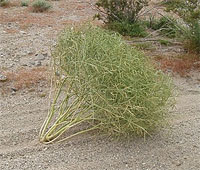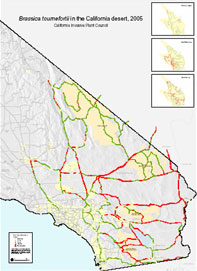The workshop and road surveys described below were conducted with financial support from the California Department of Transportation, US Fish and Wildlife Service, and Federal Highway Administration.
Background |
August 2005 Meeting Presentations |
Related links
Background information on B. tournefortii
(All information from Matt Brooks, USGS, manuscripts in preparation)

A mobile Brassica tournefortii plant, spreading seeds as it tumbles in the wind
Brassica tournefortii first appeared in North America in the Coachella Valley in the 1920’s. It has since spread west into coastal southern California, north and east through the Mojave and Sonoran deserts, and into the Colorado Plateau, primarily along roadsides. Once established, it can move into wildland areas, especially those containing sandy soils, although it can also dominate silty and rocky soils on hilltops during years of high rainfall. Dispersal is accomplished by individual seeds (spread actively by granivores or passively by wet seeds adhering to vehicles) and by entire uprooted plants (tumbling with the wind).
Potential impacts:
- Competes with and reduces the productivity of native plants
- Affects wildlife by altering the availability of forage plants and the characteristics of their habitat structure
- Promotes the spread of fire
These impacts are probable, but remain to be documented (studies are in progress)
Control strategies must focus on managing the seedbank, for instance by focusing on new populations before an extensive seedbank can become established. Methods that cause soil disturbance may exacerbate the problem if a soil seedbank has already established.
For detailed information on B. tournefortii, see presentations below.
August 2005 Meeting Presentations
On August 30, 2005, Caltrans and the Federal Highway Administration
sponsored a multi-state meeting in Barstow, CA to discuss the Saharan
mustard invasion and plan control strategies. Presentations from the
meeting are accessible below.
- Ecology of Saharan Mustard (brassica tournefortii) – Jodie S. Holt and Robin G. Marushia, UC-Riverside (593 KB)
- Ecological Effects of Saharan Mustard – Cameron Barrows, UC-Riverside’s Center for Conservation Biology & the Center for Natural Lands Management (2 MB)
- Sahara Mustard and Other Weed Hurricanes Hitting California – Steve Schoenig, Senior Environmental Research Scientist, CA Dept. of Food and Agriculture(1.5 MB)
- Saharan Mustard Control Strategies – Curt Deuser, Supervisory Restoration Biologist, National Park Service Lake Mead Exotic Plant Management Team (1.2 MB)
- Saharan Mustard Invasion History and Patterns of Spread – Matt Brooks, USGS Western Region, Western Ecological Research Center (789 KB)
- Map of Saharan Mustard distribution in Southern California – California Invasive Plant Council (2.6 MB)
- Nevada Dept. of Agriculture statewide report on Saharan Mustard – Nevada Department of Agriculture (59 KB)
- Saharan Mustard in Nevada – Josh Hoines, Research Assistant, Public Lands Institute, University of Nevada Las Vegas (1.7 MB)
- Saharan Mustard in New Mexico Mark Renz, Extention Weed Specialist, New Mexico State University (501 KB)
- Saharan Mustard in Arizona – Curt McCasland, FWS Cabeza Prieta NWR (976 KB)
Related Links
Sanders, A., and R. Minnich. 2000. Brassica tournefortii. in Bossard, C. C., J. M. Randall, and M. M. Hochovsky. Invasive Plants
of California’s Wildlands. University of California Press, Berkeley,
CA.
Northam, F.E. Invasive plant management in Arizona. Proceedings of the California Exotic Pest Plant Council 2000-02 Symposia. 6:56 (large pdf file)
Van Devender, T.R., R.S. Felger, and A. Burquez M.1997. Exotic plants in the Sonoran Desert region, Arizona and Sonora. Proceedings of the 1997 California Exotic Pest Plant Council Symposium. (pdf file)
USGS Southwest Exotic Plant Information Clearinghouse. Information on Brassica tournefortii
Arizona-Sonora Desert Museum. Flora of the Sonoran Desert Region. Brassica tournefortii – a dangerous invasive exotic weed.
The Nature Conservancy’s Invasive Species Initiative. Photos of Brassica tournefortii

